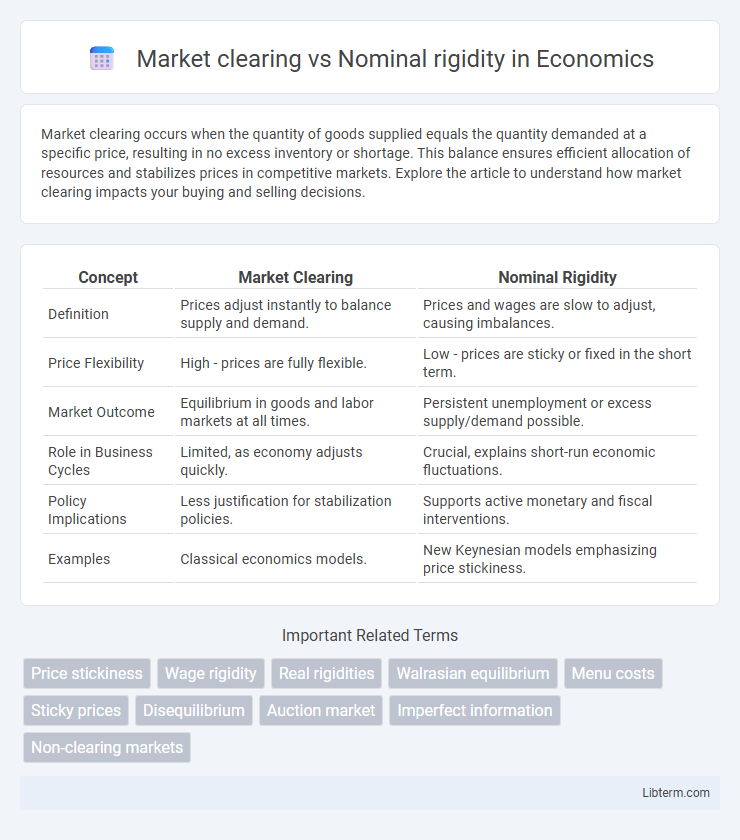Market clearing occurs when the quantity of goods supplied equals the quantity demanded at a specific price, resulting in no excess inventory or shortage. This balance ensures efficient allocation of resources and stabilizes prices in competitive markets. Explore the article to understand how market clearing impacts your buying and selling decisions.
Table of Comparison
| Concept | Market Clearing | Nominal Rigidity |
|---|---|---|
| Definition | Prices adjust instantly to balance supply and demand. | Prices and wages are slow to adjust, causing imbalances. |
| Price Flexibility | High - prices are fully flexible. | Low - prices are sticky or fixed in the short term. |
| Market Outcome | Equilibrium in goods and labor markets at all times. | Persistent unemployment or excess supply/demand possible. |
| Role in Business Cycles | Limited, as economy adjusts quickly. | Crucial, explains short-run economic fluctuations. |
| Policy Implications | Less justification for stabilization policies. | Supports active monetary and fiscal interventions. |
| Examples | Classical economics models. | New Keynesian models emphasizing price stickiness. |
Understanding Market Clearing: A Conceptual Overview
Market clearing occurs when supply equals demand at a specific price, enabling all goods in the market to be sold without surplus or shortage. Nominal rigidity, such as sticky wages or prices, prevents immediate adjustments to price changes, causing deviations from market clearing and prolonged disequilibriums. Understanding market clearing helps analyze how perfect flexibility in prices can theoretically lead to efficient resource allocation despite real-world frictions.
Defining Nominal Rigidity in Economics
Nominal rigidity in economics refers to the resistance of prices and wages to adjust immediately in response to changes in supply and demand, contrasting with the market clearing assumption where prices instantly equilibrate to clear markets. This phenomenon leads to price stickiness, causing deviations from equilibrium and contributing to short-term unemployment and output fluctuations. Understanding nominal rigidity is crucial for modeling real-world market dynamics and the effectiveness of monetary policy interventions.
Key Differences Between Market Clearing and Nominal Rigidity
Market clearing assumes prices and wages adjust instantly to equate supply and demand, ensuring markets always clear without excess supply or demand. Nominal rigidity refers to the slow adjustment of prices and wages due to contracts, menu costs, or regulations, causing temporary disequilibriums and unemployment. The key difference lies in market clearing's flexible prices versus nominal rigidity's sticky prices that prevent immediate equilibrium restoration.
Historical Perspectives on Market Clearing and Nominal Rigidity
Historical perspectives on market clearing emphasize classical economic theories where prices and wages adjust instantly to equilibrate supply and demand, ensuring markets clear without surplus or shortage. In contrast, nominal rigidity, rooted in Keynesian economics, highlights the empirical observation that prices and wages are sticky downward, preventing immediate market clearing and causing prolonged periods of unemployment or excess supply. Seminal research by economists like Keynes, Lucas, and New Keynesians reveals the pivotal role of nominal rigidities in explaining macroeconomic fluctuations and shaping monetary policy.
Market Clearing Assumptions in Classical Economics
Market clearing assumptions in classical economics imply that prices and wages adjust instantaneously to equate supply and demand in all markets, eliminating any persistent shortages or surpluses. This framework assumes flexible prices and wages, leading to full employment and efficient resource allocation without involuntary unemployment. Nominal rigidity challenges this view by highlighting that prices and wages are often sticky, preventing immediate market clearing and causing short-term disequilibria in the economy.
The Role of Nominal Rigidity in New Keynesian Models
Nominal rigidity, particularly price and wage stickiness, plays a central role in New Keynesian models by preventing instantaneous market clearing, thereby generating monetary non-neutrality and short-run economic fluctuations. Unlike classical market clearing models that assume flexible prices ensure equilibrium, New Keynesian frameworks demonstrate how sluggish price adjustments lead to deviations from full employment and output gaps. This rigidity explains the persistence of unemployment and the effectiveness of monetary policy interventions in stabilizing the economy.
Impacts on Prices and Wages: Flexibility vs. Stickiness
Market clearing models assume prices and wages adjust instantly to equilibrate supply and demand, promoting efficient allocation of resources and rapid adjustment to shocks. Nominal rigidity theories highlight the stickiness of prices and wages due to contracts, menu costs, and wage-setting norms, resulting in slower responses to economic changes and persistent unemployment. This rigidity can cause prolonged deviations from equilibrium, influencing inflation dynamics and real wage fluctuations in the labor market.
Real-World Examples of Market Clearing and Nominal Rigidity
Market clearing occurs when supply equals demand, as seen in stock markets where prices adjust rapidly to new information, ensuring all shares are bought or sold without backlog. Nominal rigidity manifests in labor markets with sticky wages, such as during recessions when firms hesitate to cut nominal wages despite reduced demand, leading to unemployment. Real-world examples of nominal rigidity include long-term employment contracts and menu costs in retail pricing, which prevent instantaneous price adjustments even as economic conditions shift.
Policy Implications: Stabilization and Economic Interventions
Market clearing assumes prices and wages adjust instantly to equilibrate supply and demand, minimizing unemployment and inflation volatility. Nominal rigidity acknowledges slow price and wage adjustments, causing output and employment fluctuations in response to shocks, necessitating active stabilization policies. Effective economic interventions under nominal rigidity include monetary easing and fiscal stimulus to offset demand shortfalls and reduce economic volatility.
Future Research Directions in Market Dynamics and Rigidity
Future research in market dynamics and nominal rigidity should explore the interaction between price adjustment mechanisms and transaction costs to better understand market clearing processes. Investigating heterogeneous agent models with varying sensitivity to nominal rigidities can reveal how micro-level frictions aggregate to macroeconomic price stickiness. Empirical analysis using high-frequency data can refine theoretical models by capturing real-time price adjustments and deviations from market-clearing equilibria.
Market clearing Infographic

 libterm.com
libterm.com